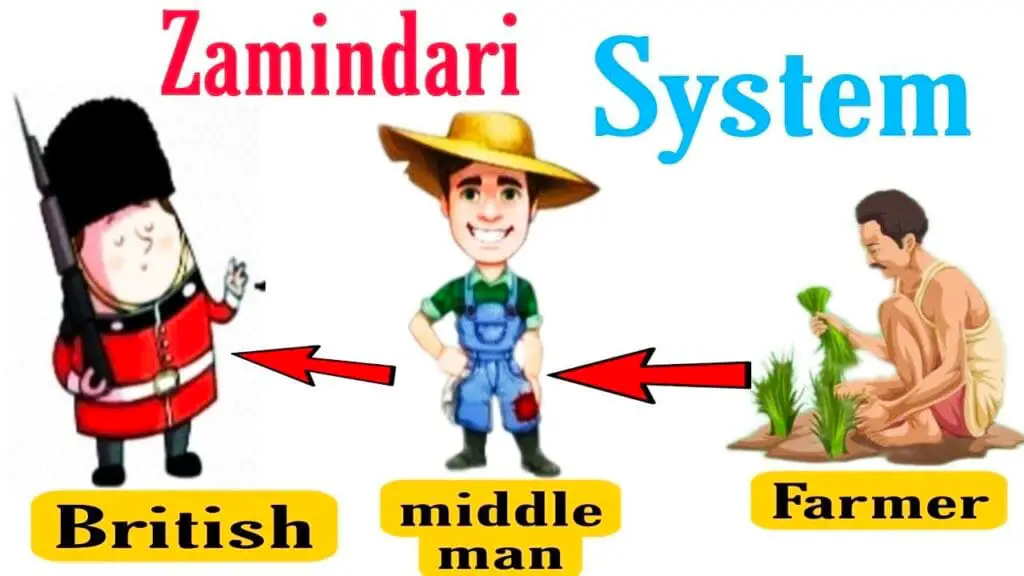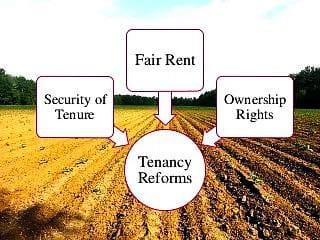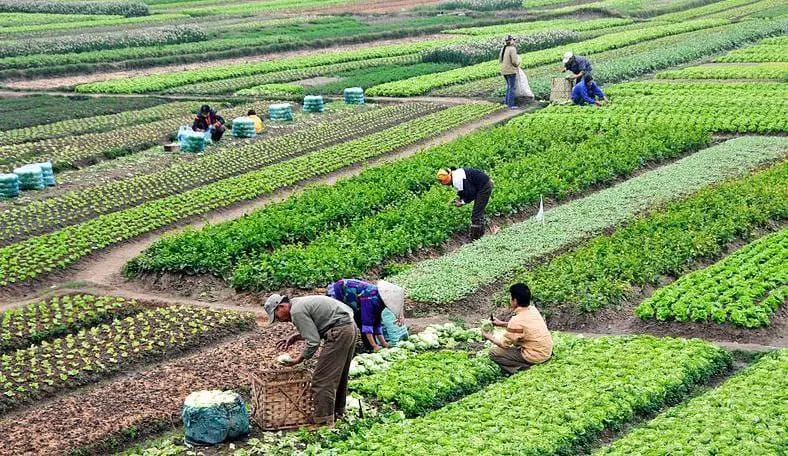Discuss The Land Reforms Taken By Government Of India.

After gaining independence in 1947, India recognized the need to address the deep-rooted agrarian issues and unequal land ownership structures that had persisted under colonial rule. The government introduced a series of land reform measures aimed at promoting social justice, improving agricultural productivity, and ensuring equitable distribution of land. The primary objectives were to abolish exploitative systems of land tenure, redistribute land, and provide security to tenants.
Here are the key land reform measures implemented by the government of India:
1. Abolition of the Zamindari System

- Objective: To dismantle the feudal system of land ownership and eliminate intermediaries like zamindars, jagirdars, and taluqdars who collected rent from tenant farmers without engaging in cultivation themselves.
- Legislation: Most states in India passed laws for the abolition of the zamindari system between the 1950s and early 1960s. For example, the Uttar Pradesh Zamindari Abolition and Land Reforms Act (1950) was one of the first pieces of legislation enacted for this purpose.
- Key Features:
- Zamindars were removed as intermediaries between the government and the actual tillers of the land.
- The tenants or actual cultivators of the land were recognized as owners of the land they cultivated.
- Compensation was paid to zamindars, but in most cases, it was far below market value.
- Impact:
- Millions of tenant farmers gained ownership rights to the land they cultivated.
- It significantly weakened the power and influence of the landlord class, leading to greater social and political mobility for the peasantry.
- However, in many cases, zamindars were able to retain large portions of their lands by manipulating loopholes in the legislation or through informal means.
2. Tenancy Reforms

- Objective: To provide security of tenure to tenant farmers, regulate rent, and ensure that tenants were not unfairly evicted from the land.
- Key Features:
- Security of Tenure: Laws were enacted to protect tenants from arbitrary eviction by landlords. Tenants were given the right to continue cultivating the land as long as they paid the rent.
- Fair Rent: The rent payable by tenants was regulated by law, often fixed at one-fourth to one-third of the produce, depending on the state. This was aimed at preventing landlords from charging exorbitant rents.
- Right to Purchase Land: In several states, tenants were given the right to purchase the land they cultivated after a certain period of time. The landowner could no longer evict the tenant without proper cause.
- Impact:
- The reforms provided protection and stability to tenants, many of whom were previously subject to exploitation and eviction.
- In some states, such as West Bengal and Kerala, tenancy reforms were more successful due to strong political will and efficient implementation.
- However, in many other states, weak implementation, loopholes in the law, and landlord resistance limited the impact of tenancy reforms.
3. Ceiling on Land Holdings

- Objective: To redistribute land by setting a legal limit on the maximum amount of land that an individual or family could own. The excess land (above the ceiling limit) was to be taken by the government and redistributed to landless and marginal farmers.
- Legislation: The government introduced land ceiling laws in two phases:
- First Phase (1950s and 1960s): In this phase, land ceiling limits were set too high, and large landowners were able to evade the laws by transferring land to family members or using benami (false) transactions.
- Second Phase (1972-1976): The limits were reduced in the 1970s to make land redistribution more effective. The new laws were stricter, and the emphasis was placed on identifying and redistributing surplus land.
- Key Features:
- The ceiling limit varied from state to state, depending on factors like the type of land (irrigated or non-irrigated) and local agricultural conditions. For example, in Punjab, the ceiling was set at 17.5 acres for irrigated land and 52.5 acres for non-irrigated land.
- Land in excess of the ceiling limit was to be acquired by the government and redistributed to the landless.
- Impact:
- While land ceiling laws were intended to promote equity, their implementation was often weak, and large landowners found ways to circumvent the laws.
- Nevertheless, in states like West Bengal and Kerala, the laws were enforced more effectively, leading to the redistribution of significant amounts of land.
- Nationally, however, the amount of land actually redistributed remained below expectations due to legal loopholes and weak enforcement mechanisms.
4. Consolidation of Landholdings
- Objective: To consolidate fragmented and scattered landholdings to improve agricultural productivity and make it easier for farmers to manage and cultivate their land.
- Background: Due to inheritance laws and population growth, agricultural landholdings in India became increasingly fragmented. Farmers often owned small, scattered plots of land, making efficient cultivation difficult.
- Key Features:
- The government initiated land consolidation programs in several states, aimed at merging fragmented holdings into single, contiguous plots.
- The goal was to provide each farmer with a consolidated block of land that would be easier to cultivate using modern farming techniques and mechanization.
- Impact:
- The consolidation of landholdings was relatively successful in states like Punjab and Haryana, where large-scale consolidation programs were implemented.
- In other regions, however, the success was limited due to resistance from landowners and issues related to inheritance disputes.
- Consolidation helped increase agricultural productivity in regions where it was effectively implemented, as it facilitated the use of modern agricultural methods and improved irrigation.
5. Bhoodan and Gramdan Movements

- Objective: These were voluntary land reform movements aimed at promoting equitable land distribution through non-violent means.
- Bhoodan Movement:
- Initiated by Vinoba Bhave in 1951, the Bhoodan (land gift) movement aimed to persuade wealthy landowners to voluntarily donate land to landless farmers.
- Bhave traveled across the country, appealing to landlords to donate a portion of their land for redistribution to the poor.
- Gramdan Movement:
- Building on the Bhoodan movement, the Gramdan (village gift) movement encouraged entire villages to donate land for collective ownership.
- The idea was to create a system of cooperative farming, where land would be collectively owned and cultivated by the village community.
- Impact:
- The Bhoodan movement succeeded in mobilizing a significant amount of land for redistribution. By the mid-1960s, around 4 million acres of land had been donated.
- However, much of the donated land was of poor quality, and many donations were never fully implemented due to administrative and legal challenges.
- Despite its limitations, the movement created awareness about land inequality and inspired further land reform efforts.
6. Land to the Tiller
- Objective: To provide ownership rights to the actual cultivators of the land.
- Implementation:
- States like West Bengal, under the leadership of Jyoti Basu, implemented the Operation Barga program in the late 1970s and early 1980s. This was a tenancy reform program aimed at recording the names of sharecroppers (known as bargadars) and giving them legal protection against eviction.
- Sharecroppers were given greater rights to the land they cultivated, and their share of the produce was regulated by law.
- Impact:
- Operation Barga was one of the most successful land reform programs in India, significantly improving the rights and livelihoods of sharecroppers in West Bengal.
- The program reduced the influence of landlords and gave tenants greater security, leading to higher agricultural productivity in the state.
7. Land Redistribution
- Objective: To address landlessness by redistributing government land, surplus land acquired through land ceiling laws, and other available resources.
- Key Features:
- Landless farmers were given ownership rights to government wasteland, surplus land, or donated land.
- Several state governments took steps to identify surplus land and redistribute it among the landless, though implementation was often slow and inefficient.
- Impact:
- The redistribution of land to landless farmers improved the livelihoods of many poor rural households. However, the scale of redistribution was limited due to administrative challenges, legal disputes, and resistance from large landowners.
Challenges in Implementing Land Reforms

- Lack of Political Will: In many cases, the implementation of land reforms was weak due to a lack of political will and pressure from influential landowners.
- Legal Loopholes: Large landowners exploited legal loopholes and often transferred land to relatives or created benami (false) holdings to avoid ceiling laws.
- Poor Record-Keeping: The lack of accurate land records made it difficult to enforce tenancy rights and ceiling laws effectively.
- Bureaucratic Inefficiencies: Delays in the judicial and administrative systems, corruption, and lack of coordination between agencies further hampered the success of land reforms.
Conclusion
While the Land Reforms undertaken by the government of India after independence marked a significant effort to address agrarian inequalities and improve the condition of farmers, the overall success was mixed. States like West Bengal.














Post Comment